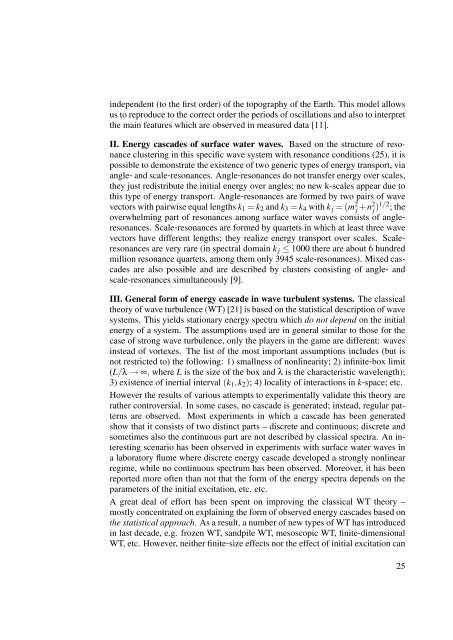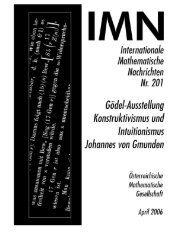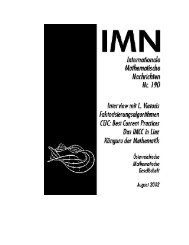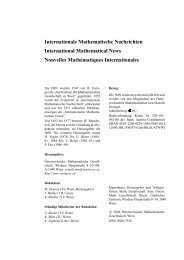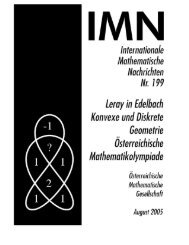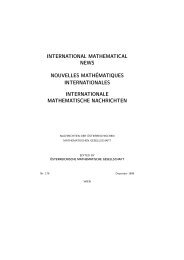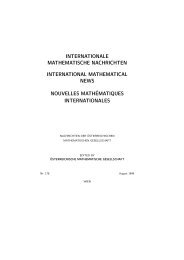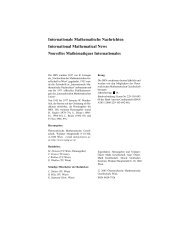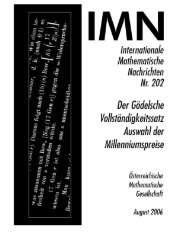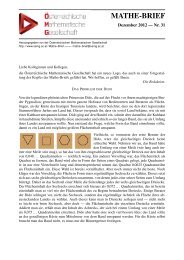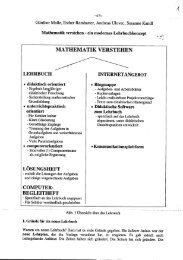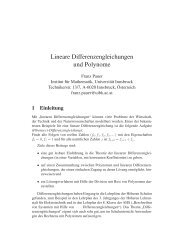218 - Ãsterreichische Mathematische Gesellschaft
218 - Ãsterreichische Mathematische Gesellschaft
218 - Ãsterreichische Mathematische Gesellschaft
Erfolgreiche ePaper selbst erstellen
Machen Sie aus Ihren PDF Publikationen ein blätterbares Flipbook mit unserer einzigartigen Google optimierten e-Paper Software.
independent (to the first order) of the topography of the Earth. This model allows<br />
us to reproduce to the correct order the periods of oscillations and also to interpret<br />
the main features which are observed in measured data [11].<br />
II. Energy cascades of surface water waves. Based on the structure of resonance<br />
clustering in this specific wave system with resonance conditions (25), it is<br />
possible to demonstrate the existence of two generic types of energy transport, via<br />
angle- and scale-resonances. Angle-resonances do not transfer energy over scales,<br />
they just redistribute the initial energy over angles; no new k-scales appear due to<br />
this type of energy transport. Angle-resonances are formed by two pairs of wave<br />
vectors with pairwise equal lengths k 1 = k 2 and k 3 = k 4 with k j = (m 2 j +n2 j )1/2 ; the<br />
overwhelming part of resonances among surface water waves consists of angleresonances.<br />
Scale-resonances are formed by quartets in which at least three wave<br />
vectors have different lengths; they realize energy transport over scales. Scaleresonances<br />
are very rare (in spectral domain k j ≤ 1000 there are about 6 hundred<br />
million resonance quartets, among them only 3945 scale-resonances). Mixed cascades<br />
are also possible and are described by clusters consisting of angle- and<br />
scale-resonances simultaneously [9].<br />
III. General form of energy cascade in wave turbulent systems. The classical<br />
theory of wave turbulence (WT) [21] is based on the statistical description of wave<br />
systems. This yields stationary energy spectra which do not depend on the initial<br />
energy of a system. The assumptions used are in general similar to those for the<br />
case of strong wave turbulence, only the players in the game are different: waves<br />
instead of vortexes. The list of the most important assumptions includes (but is<br />
not restricted to) the following: 1) smallness of nonlinearity; 2) infinite-box limit<br />
(L/λ → ∞, where L is the size of the box and λ is the characteristic wavelength);<br />
3) existence of inertial interval (k 1 ,k 2 ); 4) locality of interactions in k-space; etc.<br />
However the results of various attempts to experimentally validate this theory are<br />
rather controversial. In some cases, no cascade is generated; instead, regular patterns<br />
are observed. Most experiments in which a cascade has been generated<br />
show that it consists of two distinct parts – discrete and continuous; discrete and<br />
sometimes also the continuous part are not described by classical spectra. An interesting<br />
scenario has been observed in experiments with surface water waves in<br />
a laboratory flume where discrete energy cascade developed a strongly nonlinear<br />
regime, while no continuous spectrum has been observed. Moreover, it has been<br />
reported more often than not that the form of the energy spectra depends on the<br />
parameters of the initial excitation, etc. etc.<br />
A great deal of effort has been spent on improving the classical WT theory –<br />
mostly concentrated on explaining the form of observed energy cascades based on<br />
the statistical approach. As a result, a number of new types of WT has introduced<br />
in last decade, e.g. frozen WT, sandpile WT, mesoscopic WT, finite-dimensional<br />
WT, etc. However, neither finite-size effects nor the effect of initial excitation can<br />
25


